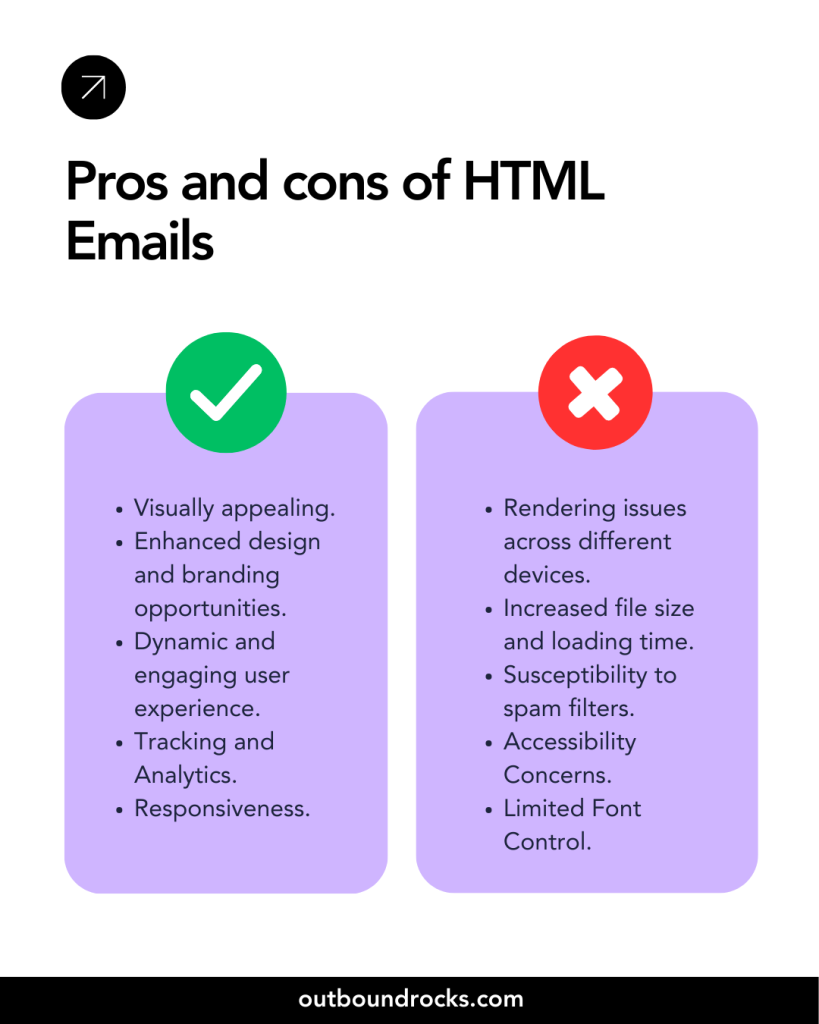Choosing the right format for your emails can feel like navigating a minefield.
In 2024, with inboxes overflowing and attention spans shorter than ever, should you choose the clean simplicity of plain text or the visual appeal of HTML? Does one format reign supreme, or is the answer more strategic?
In this article, we will unpack the strengths and weaknesses of both plain text and HTML email and analyze their impact on deliverability, engagement, and user experience. We’ll also reveal a surprising truth: the “best” format depends entirely on your specific goals.
Get ready to discover the email format that can transform your marketing strategy.
TABLE OF CONTENTS
– Pros and cons of Plain Text Emails
– Pros and cons of HTML Emails
– Plain text emails vs. HTML in 2024
– Conclusions
Pros and cons of Plain Text Emails
In the battle between plain text and HTML emails, understanding the advantages and limitations of each format is crucial. Let’s delve into the world of plain text emails, exploring both their strengths and weaknesses:
Advantages of Plain Text Emails
- Accessibility and compatibility: Plain text emails are universally accessible. They render flawlessly across all devices and email clients, ensuring your message reaches everyone on your list, regardless of their tech setup. This is particularly important for audiences using older devices or with limited bandwidth.
- Lightweight and fast-loading: Free from bulky images and complex formatting, plain text emails are light on data and load instantly. This translates to a smoother user experience, especially for those with slow internet connections. Faster loading times can also lead to higher engagement, as readers are less likely to click away due to a lagging email.
- Enhanced deliverability and inbox placement: Spam filters often view HTML emails with suspicion due to the potential for embedded code or malicious content. Plain text emails, on the other hand, are less likely to be flagged as spam, increasing the chances of landing safely in your recipient’s inbox. This can significantly boost your email marketing campaign’s overall reach and effectiveness.
Limitations of Plain Text Emails
- Lack of visual appeal and branding opportunities: Let’s face it, plain text emails can appear, well, plain. Without visuals like logos, images, or colors, it can be challenging to create a visually appealing and memorable brand experience. Standing out in a crowded inbox can be a struggle without the ability to leverage captivating design elements.
- Limited design and formatting options: Bold, italics, and bullet points are the extent of your formatting options with plain text. This can make it difficult to structure your email and draw attention to specific calls to action (CTAs). While a skilled copywriter can still craft compelling content, the lack of visual hierarchy often present in HTML emails can be a drawback.

Pros and cons of HTML Emails
Now, let’s shift gears and explore the world of HTML emails, where creativity takes center stage:
Advantages of HTML emails:
- Rich multimedia content (images, videos, interactive elements): HTML emails unleash the power of visuals. Embed captivating images, showcase product demos with short videos, or even incorporate interactive elements like polls or surveys. This multimedia richness allows you to create a more engaging and dynamic user experience, grabbing attention and leaving a lasting impression.
- Enhanced design and branding opportunities: HTML emails are a branding playground. Use colors, fonts, and logos to create a visually cohesive and memorable brand experience. This not only reinforces brand recognition but also sets a professional tone and builds trust with your audience.
- Dynamic and engaging user experience: With HTML, you can break free from the monotony of plain text. Structure your email with clear calls to action (CTAs), use buttons and hyperlinks for easy navigation, and incorporate responsive design to ensure flawless display across different devices. This dynamic approach fosters a more interactive and engaging experience for your readers.
Limitations of HTML emails:
- Rendering issues across different email clients and devices: The beauty of HTML emails can sometimes be a double-edged sword. Complex formatting or embedded elements might not render consistently across all email clients and devices. This can lead to a frustrating user experience for some recipients and potentially distort your intended message.
- Increased file size and loading time: Images, videos, and complex formatting all contribute to a larger file size for HTML emails. This can lead to slower loading times, especially for users with limited bandwidth. A slow-loading email can negatively impact engagement, with impatient readers clicking away before your message even appears.
- Susceptibility to spam filters and deliverability challenges: Spam filters are wary of flashy HTML emails, particularly those containing excessive images or embedded code. This can increase the risk of your email landing in the spam folder instead of the inbox. Careful design and coding practices are crucial to ensure optimal deliverability for your HTML campaigns.

HTML vs Plain Text Email in 2024: and the winner is…
So we’ve weighed the pros and cons of plain text and HTML email. But the burning question remains: which format will reign supreme in the email marketing landscape of 2024?
As we said, at Outbound Rocks we only send plain text emails because that is the natural way people interact with each other in email communication. For us, this is a good approach because we are basically mimicking human behavior.
But the truth is, there’s no single, definitive answer. The “best” format depends entirely on your specific goals and audience.
- If you prioritize accessibility and deliverability go plain text: If making sure your message reaches everyone on your list and avoiding spam filters is paramount, plain text is the clear winner.
- If you value visual appeal and engagement embrace HTML: When it comes to building brand awareness, showcasing products, or driving clicks with dynamic CTAs, HTML takes the crown.
Conclusions
In summary, the key is to understand your audience and tailor your email format accordingly. A/B testing different formats and analyzing the results can further refine your strategy and ensure you’re reaching your audience in the most effective way.
Ready to take your email marketing to the next level? Try our free demo today and discover how Outbound Rocks can help you optimize your sales funnel and connect with your ideal prospects.
